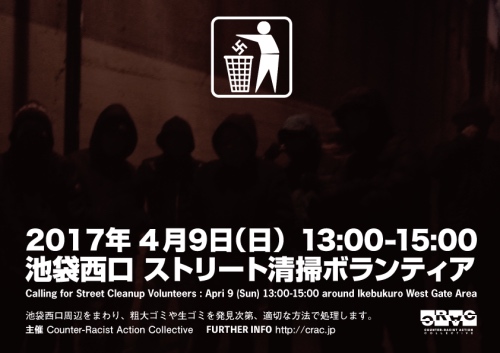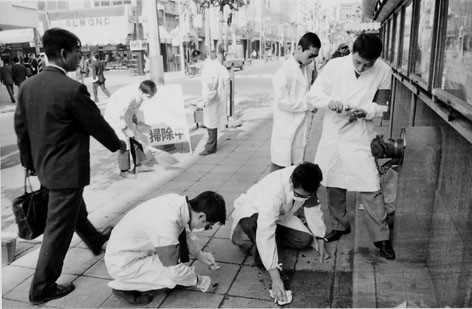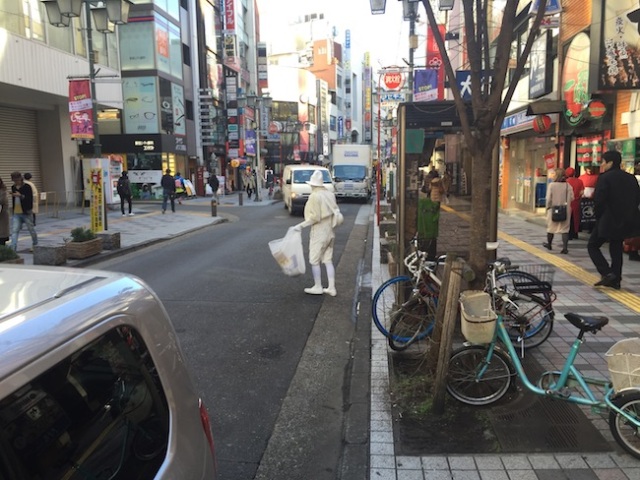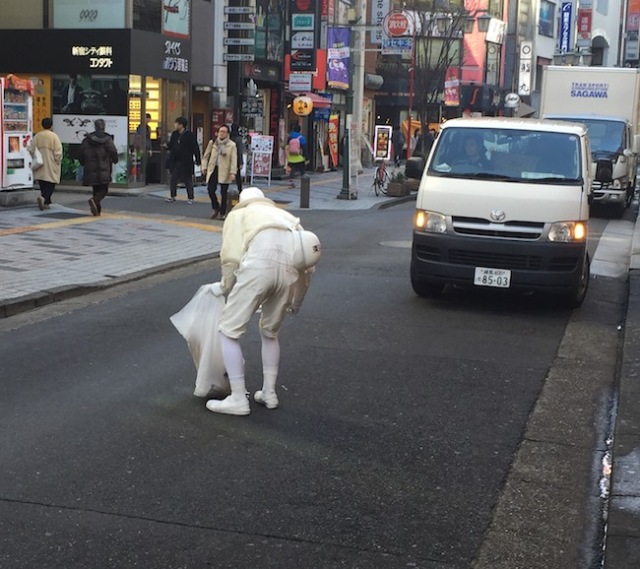In the post-digital world perhaps the greatest accolade is that
of “going viral”. We trawl our screens in a desperate daily search for
the latest photo or video to bear that badge.
One of the latest is the image of Saffiyah Khan calmly facing off against the far-right English Defence League in Birmingham. While far less dramatic (and, for better or worse, viral), Tokyo witnessed some similar confrontations on April 9th. The ultra-nationalist Japan First Party called for a “voluntary cleanup” in Ikebukuro, north-west Tokyo, where participants would ostensibly pick up waste and litter. Such events have been held in the past in Ikebukuro, an area of Tokyo with a significant Chinese and non-Japanese population, and participants would carry nationalist flags and use the event as an excuse to shout verbal abuse at certain Chinese grocery store.
 Japan First Party’s call was answered by a handful of people and a
much larger police presence and counter-protest by Counter-Racist Action
Collective (C.R.A.C.), who, according to the group’s website,
blocked the progress of the participants and forced them to do the very
task that they had
Japan First Party’s call was answered by a handful of people and a
much larger police presence and counter-protest by Counter-Racist Action
Collective (C.R.A.C.), who, according to the group’s website,
blocked the progress of the participants and forced them to do the very
task that they had
ostensibly said they would do: voluntary neighbourhood cleanup.
This confrontation in Ikebukuro was swiftly followed by another counter-protest against an anti-Korean march in Shinjuku from 3pm, led by Shūsei Sakurada’s New Social Movement. No one picked up litter this time; it was a more run-of-the-mill hate speech march with the prerequisite nationalist flags and aggressive slogans. The resulting chaotic scenes in the heart of Shinjuku during the peak weekend shopping period left rows of bystanders, including foreign tourists, fazed.
While xenophobic and racist movements existed in Japan before, the 2011 tsunami and subsequent social uncertainty it ushered in seemed to compel, or at least coincide with, an increase in what became known as “hate speech” protests. These marches now happen regularly around Japan, always met by counter-protests organised assiduously by the likes of C.R.A.C. and other antifa groups. Another rally is scheduled to take place on April 23rd in Kyoto, the biggest tourist destination in the country. Much like the traditional uyoku ultra-nationalists and their black vans, these hate speech groups (and the ancillary role of the counter-protestors) have become part of the noisy bedlam of the Japanese city: a hubbub which includes pachinko parlours, constant announcements and the din of advertising trucks. It is all mere clamour that is soon lost in the ether.
Or is it? Counter-protests dismiss the hate speech marchers as “scum” (language arguably not so dissimilar to the insults the ultra-nationalists and racists themselves use) while liberals are prone to dismiss them as sad men unable to express their masculinity otherwise. But Zaitokukai’s former leader, Makoto Sakurai, got 114,171, or 1.74%, of votes at the Tokyo gubernatorial election in 2016, which is not too shabby for an brazen extremist and unpleasant individual. (In February 2017, Sakurai formed the Japan First Party, which is said to have around 1,600 members — many, many more than, say, SEALDs, despite the media fanfare.) Should we be worried? One thing is for sure: this should not be lazily equated with the strength of the right-wing Abe administration, with its tendencies towards such initiatives as reintroducing the Imperial Rescript in schools, or the success of such conservative populists as Yuriko Koike, who soundly beat Sakurai (and all comers) for the position of governor.
The courts and police have been cracking down, at any rate, and even the central government has made some token gestures. A new law was passed in 2016 aimed at curbing hate speech, though critics say it is largely toothless since it carries no penalty, has limited scope and is failing to not stop racist rallies from happening. Instead, local governments like Osaka and Kawasaki, which have sizeable Zainichi Korean communities, have been stepping up to provide more effective legislation and tackle the problem themselves.
One thing is for sure: come 2020 and the Olympics, the authorities do not want any hate speech rallies spoiling the public veneer of “Omotenashi” (hospitality) that Tokyo is at pains to stress at every turn. A firmer cleanup will be necessary to avoid inconveniently blemishing the official line.
In Shintō, the visitor to a shrine is supposed to cleanse themselves with water at the chōzuya (or temizuya), an ablution basin. The meaning is clear: a shrine is a sacred place; bringing in a sullied body defiles the site. But how to purify a whole city? Gentrification is one solution, as they are doing in Kabukichō; as they are doing in Shibuya with expelling the homeless from Miyashita Park. Glass towers are rising, along with rents from tenants, no doubt. There are even rumours that the generous cache of pornographic magazines always available at any convenience store in the land may temporarily disappear during the Olympics.
Cleaning can, then, be oppressive and racist. It can also be mockery and satire, or performative and fun. Ahead of the 1964 Olympics, the government launched a large-scale effort to clean up Tokyo so it would appear gleaming for the world’s cameras. This was famously ridiculed by the anti-art group Hi-Red Center, who arrived in Ginza one day with lab coats to scrub the streets.
 Last year the “samurai trash collectors” generated some online attention. These costumed men, a performance troupe called Jidaigumi Basara,
can be spotted on Sundays around Shibuya, swopping down in synchronised
movements to pick up offending items of trash on the street. This is,
of course, a gimmick and intended as a promotion for the group, though
it has some flair and charm.
Last year the “samurai trash collectors” generated some online attention. These costumed men, a performance troupe called Jidaigumi Basara,
can be spotted on Sundays around Shibuya, swopping down in synchronised
movements to pick up offending items of trash on the street. This is,
of course, a gimmick and intended as a promotion for the group, though
it has some flair and charm.


In February I chanced upon a similar performer in Shinjuku, dressed all in white (including make-up on his face, gloves and leggings) as he walked around silently collecting litter from the street. All but ignored by fellow denizens on this quiet weekday afternoon, was his act of performative waste collection one of protest or civil responsibility?
One of the latest is the image of Saffiyah Khan calmly facing off against the far-right English Defence League in Birmingham. While far less dramatic (and, for better or worse, viral), Tokyo witnessed some similar confrontations on April 9th. The ultra-nationalist Japan First Party called for a “voluntary cleanup” in Ikebukuro, north-west Tokyo, where participants would ostensibly pick up waste and litter. Such events have been held in the past in Ikebukuro, an area of Tokyo with a significant Chinese and non-Japanese population, and participants would carry nationalist flags and use the event as an excuse to shout verbal abuse at certain Chinese grocery store.

Announcement
by Counter-Racist Action Collective (C.R.A.C.) calling for a
counter-cleanup in Ikebukuro on April 9th, 2017, in response to an event
organised by the far-right Japan First Party
ostensibly said they would do: voluntary neighbourhood cleanup.
This is what happened on last Sunday.The “funny” counter-protest was a kind of détournement: the anti-fascists plagiarised the activities of the hate group and subverted the intention of the event.
Extreme right wingers declared street cleanup in Chinese enclave in Ikebukuro, where they have often targeted and vandalized a certain glossary store run by Chinese immigrants for years. They said they must clean up the vicinity because the town are so messed up with a lot of garbages because there are so many Chinese people there. Yes, they had racist purpose behind the “cleaning” activity.
Antifascists also declared cleanup activities there on exactly the same day and time, suggesting proper disposal of “Bulk Wastes”. The “Bulk Wastes” means right wing human scum, of course.
At 14:00, several racists showed up and actually began to picking up small wastes and trashes. But they were surrounded by 15 times more antifascists and also a huge amount of police officers.
Apparently what they really wanted to do was throwing hate speeches onto Chinese owned stores pretending as if they came across there while cleaning up the vicinity.
But thanks for truly volunteer antifas, they couldn’t even come close to any stores in the area. Therefore hatemongers had no alternative but to throw themselves just into real cleanup activities in the occasional rain being harshly yelled off by angry antifas.
It was the funniest counter-protest ever happened in Japan recently.
This confrontation in Ikebukuro was swiftly followed by another counter-protest against an anti-Korean march in Shinjuku from 3pm, led by Shūsei Sakurada’s New Social Movement. No one picked up litter this time; it was a more run-of-the-mill hate speech march with the prerequisite nationalist flags and aggressive slogans. The resulting chaotic scenes in the heart of Shinjuku during the peak weekend shopping period left rows of bystanders, including foreign tourists, fazed.
While xenophobic and racist movements existed in Japan before, the 2011 tsunami and subsequent social uncertainty it ushered in seemed to compel, or at least coincide with, an increase in what became known as “hate speech” protests. These marches now happen regularly around Japan, always met by counter-protests organised assiduously by the likes of C.R.A.C. and other antifa groups. Another rally is scheduled to take place on April 23rd in Kyoto, the biggest tourist destination in the country. Much like the traditional uyoku ultra-nationalists and their black vans, these hate speech groups (and the ancillary role of the counter-protestors) have become part of the noisy bedlam of the Japanese city: a hubbub which includes pachinko parlours, constant announcements and the din of advertising trucks. It is all mere clamour that is soon lost in the ether.
Or is it? Counter-protests dismiss the hate speech marchers as “scum” (language arguably not so dissimilar to the insults the ultra-nationalists and racists themselves use) while liberals are prone to dismiss them as sad men unable to express their masculinity otherwise. But Zaitokukai’s former leader, Makoto Sakurai, got 114,171, or 1.74%, of votes at the Tokyo gubernatorial election in 2016, which is not too shabby for an brazen extremist and unpleasant individual. (In February 2017, Sakurai formed the Japan First Party, which is said to have around 1,600 members — many, many more than, say, SEALDs, despite the media fanfare.) Should we be worried? One thing is for sure: this should not be lazily equated with the strength of the right-wing Abe administration, with its tendencies towards such initiatives as reintroducing the Imperial Rescript in schools, or the success of such conservative populists as Yuriko Koike, who soundly beat Sakurai (and all comers) for the position of governor.
The courts and police have been cracking down, at any rate, and even the central government has made some token gestures. A new law was passed in 2016 aimed at curbing hate speech, though critics say it is largely toothless since it carries no penalty, has limited scope and is failing to not stop racist rallies from happening. Instead, local governments like Osaka and Kawasaki, which have sizeable Zainichi Korean communities, have been stepping up to provide more effective legislation and tackle the problem themselves.
One thing is for sure: come 2020 and the Olympics, the authorities do not want any hate speech rallies spoiling the public veneer of “Omotenashi” (hospitality) that Tokyo is at pains to stress at every turn. A firmer cleanup will be necessary to avoid inconveniently blemishing the official line.
In Shintō, the visitor to a shrine is supposed to cleanse themselves with water at the chōzuya (or temizuya), an ablution basin. The meaning is clear: a shrine is a sacred place; bringing in a sullied body defiles the site. But how to purify a whole city? Gentrification is one solution, as they are doing in Kabukichō; as they are doing in Shibuya with expelling the homeless from Miyashita Park. Glass towers are rising, along with rents from tenants, no doubt. There are even rumours that the generous cache of pornographic magazines always available at any convenience store in the land may temporarily disappear during the Olympics.
Cleaning can, then, be oppressive and racist. It can also be mockery and satire, or performative and fun. Ahead of the 1964 Olympics, the government launched a large-scale effort to clean up Tokyo so it would appear gleaming for the world’s cameras. This was famously ridiculed by the anti-art group Hi-Red Center, who arrived in Ginza one day with lab coats to scrub the streets.

Hi-Red Center “cleaning” the streets of Ginza in 1964


In February I chanced upon a similar performer in Shinjuku, dressed all in white (including make-up on his face, gloves and leggings) as he walked around silently collecting litter from the street. All but ignored by fellow denizens on this quiet weekday afternoon, was his act of performative waste collection one of protest or civil responsibility?

No comments:
Post a Comment